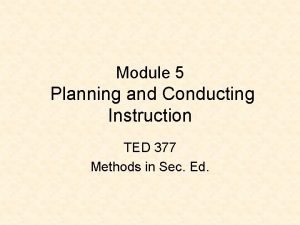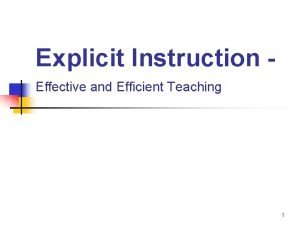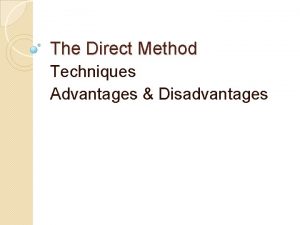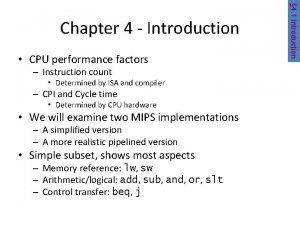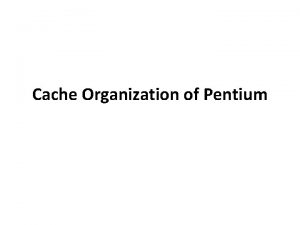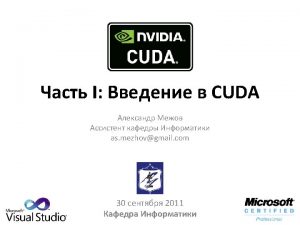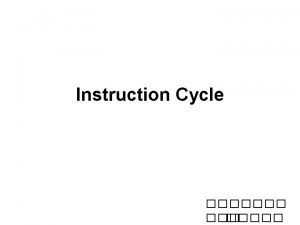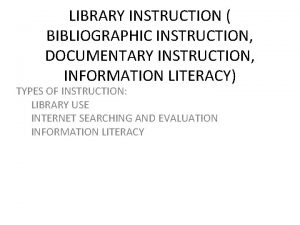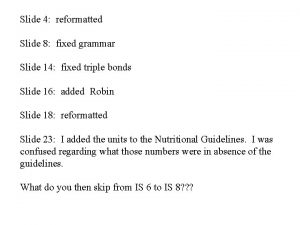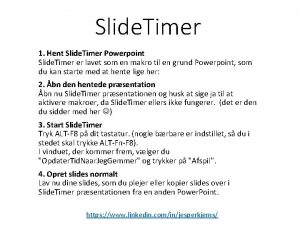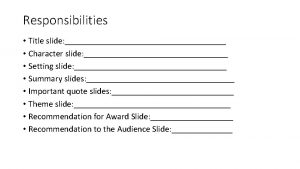Instruction Slide This is an instruction slide and

















- Slides: 17

Instruction Slide • This is an instruction slide and should be deleted after you have finished editing the presentation • You should save this presentation first by clicking on File at the top menu, then choosing Save As. • Make any edits to the slides, then delete this slide and save your presentation. If you make a mistake, you can always go back to Advisor. Intelligence and download a new copy.


About Litman Gregory

Research is the Foundation of our Businesses Our web-based research publishing service for fellow investment professionals Litman Gregory portfolios in a simple turnkey solution Litman Gregory’s core wealth management business Litman Gregory’s family of proprietary sub-advised mutual funds

Your Outsourced Research Team

Our Core Investment Beliefs

Our Investment Process

Litman Gregory Model Portfolios We believe harnessing the ideal use of active and passive builds cost-effective portfolios with optimal risk exposures.

Five Risk-Defined Strategic Allocations Equity-Like Risk Though Litman Gregory attempts not to exceed the loss threshold, losses sometimes exceed the threshold in a 12 -month period. Though we don’t believe it is likely this maximum loss threshold would be breached in a typical market cycle, losses in excess of the threshold do occur, and significant breaches of this loss threshold can be expected during extreme bear markets. The above allocations represent our strategic portfolio weightings.

Best-of-Class Manager Selection QUANTITATIVE REVIEW FACTORS: • Performance consistency • Holdings analysis • Expenses • Risk-adjusted returns vs. peers • Volatility and downside risk QUALITATIVE REVIEW FACTORS: • Integrity and discipline • A sustainable, repeatable edge • Stability and culture of the organization • Quality of the team • Shareholder orientation • “Intuition” is not part of the team’s process 9

In-Depth, Institutional-Quality Research 10

Save Time and Communicate with Confidence Paid subscribers are free to repurpose and redistribute these communications in their own practice as long as they adhere to our attribution and disclosure policy. 11

A History of Long-Term Outperformance See Strategic Allocations disclosure slide for a full description of the strategic benchmark allocation.

Risk Management • Broad geographic and asset class diversification • Scenario analysis and stress-testing • Portfolios managed to 12 -month target maximum downside thresholds

Important Disclosures The performance record for Advisor. Intelligence is based on the model portfolios published by Litman Gregory since 1989 (the “track record”). We cannot accept any legal or regulatory responsibility for Advisor. Intelligence subscribers who choose to show this track record to their current or potential clients (together “clients”) when describing any investment strategy that is based wholly or in part on Litman Gregory Advisor. Intelligence model portfolios. We also ask that you specifically not cite our track record with clients in ways that are inappropriate. Model portfolio returns reflect only theoretical returns and may differ significantly from results achieved for actual managed accounts. The model portfolio results portrayed reflect the reinvestment of distributions and the cost of fund expenses, but not the deduction of costs, including management fees, that would have been payable by the model portfolio if it were an actual account managed by Advisor. Intelligence. Hypothetical performance calculated as of month-end unless otherwise specified. This presentation is limited to the dissemination of general information pertaining to Litman Gregory Analytics, LLC (“LGA”), including information about LGA’s research publishing services, investment philosophy, and general economic market conditions. This communication contains general information that is not suitable for everyone. The information contained herein should not be construed as personalized investment advice, and should not be considered as a solicitation to buy or sell any security or engage in a particular investment strategy. Nothing herein should be construed as legal or tax advice, and you should consult with a qualified attorney or tax professional before taking any action. Information presented herein is subject to change without notice. Past performance is no guarantee of future results, and there is no guarantee that the views and opinions expressed in this newsletter will come to pass. Individual client needs, asset allocations, and investment strategies differ based on a variety of factors. The Litman Gregory companies that manage assets include Litman Gregory Asset Management, LLC and Litman Gregory Fund Advisors, LLC. Balanced Model: Losses of 10% are tolerable. Though we don’t believe it is likely this maximum loss threshold would be breached in a typical market cycle, losses in excess of 10% do occur, and significant breaches of this loss threshold can be expected during extreme bear markets. As of 3/31/21, approximately 116 advisory firms were implementing Litman Gregory’s research and model portfolio recommendations through their subscription to Advisor. Intelligence.

Strategic Allocations Beginning in 2012, our model benchmarks were changed to reflect the following strategic allocations: Defensive Balanced—consists of an 80% weighting to the Vanguard Total Bond Market Index, 10% weighting in the Vanguard 500 Index, 2% weighting in the i. Shares Russell 2000 ETF, 4% weighting in the Vanguard FTSE Developed Markets ETF, and 4% weighting in the Vanguard FTSE Emerging Markets ETF. Conservative Balanced—consists of a 60% weighting in the Vanguard Total Bond Market Index, 20% weighting in the Vanguard 500 Index, 4% weighting in the i. Shares Russell 2000 ETF, 8% weighting in the Vanguard FTSE Developed Markets ETF, and 8% in the Vanguard FTSE Emerging Markets ETF. Balanced—consists of a 40% weighting in the Vanguard Total Bond Market Index, 30% weighting in the Vanguard 500 Index, 6% weighting in the i. Shares Russell 2000 ETF, 12% weighting in the Vanguard FTSE Developed Markets ETF, and 12% in the Vanguard FTSE Emerging Markets ETF. Equity-Tilted Balanced—consists of a 25% weighting in the Vanguard Total Bond Market Index, 37% weighting in the Vanguard 500 Index, 8% weighting in the i. Shares Russell 2000 ETF, 15% weighting in the Vanguard FTSE Developed Markets ETF, and 15% in the Vanguard FTSE Emerging Markets ETF. Equity—consists of a 50% weighting in the Vanguard 500 Index, 10% weighting in the i. Shares Russell 2000 ETF, 20% weighting in the Vanguard FTSE Developed Markets ETF, and 20% in the Vanguard FTSE Emerging Markets ETF. From June 30, 2003 – December 31, 2011, our strategic allocations were as follows: Defensive Balanced—consisted of an 80% weighting in the Vanguard Total Bond Market Index, 14% weighting in the Vanguard 500 Index, 3% weighting in the i. Shares Russell 2000 ETF, and 3% weighting in the Vanguard Total Int'l Stock Index. Conservative Balanced—consisted of a 60% weighting in the Vanguard Total Bond Market Index, 30% weighting in the Vanguard 500 Index, 5% weighting in the i. Shares Russell 2000 ETF, and 5% weighting in the Vanguard Total Int'l Stock Index. Balanced—consisted of a 40% weighting in the Vanguard Total Bond Market Index, 40% weighting in the Vanguard 500 Index, 8% weighting in the i. Shares Russell 2000 ETF, and 12% weighting in the Vanguard Total Int'l Stock Index. Equity-Tilted Balanced—consisted of a 25% weighting in the Vanguard Total Bond Market Index, 50% weighting in the Vanguard 500 Index, 10% weighting in the i. Shares Russell 2000 ETF, and 15% weighting in the Vanguard Total Int'l Stock Index. Equity—consisted of 65% weighting in the Vanguard 500 Index, 15% weighting in the i. Shares Russell 2000 ETF, and 20% weighting in the Vanguard Total Int'l Stock Index

Strategic Allocations (cont’d) From January 1, 1999 – June 30, 2003, our strategic allocations were as follows: Defensive Balanced—consisted of an 80% weighting in the Vanguard Total Bond Market Index, 14% weighting in the Vanguard 500 Index, 3% weighting in the Vanguard Small Cap Index, and 3% weighting in the Vanguard Total Int'l Stock Index. Conservative Balanced—consisted of a 60% weighting in the Vanguard Total Bond Market Index, 30% weighting in the Vanguard 500 Index, 5% weighting in the Vanguard Small Cap Index, and 5% weighting in the Vanguard Total Int'l Stock Index. Balanced—consisted of a 40% weighting in the Vanguard Total Bond Market Index, 40% weighting in the Vanguard 500 Index, 8% weighting in the Vanguard Small Cap Index, and 12% weighting in the Vanguard Total Int'l Stock Index. Equity-Tilted Balanced—consisted of a 25% weighting in the Vanguard Total Bond Market Index, 50% weighting in the Vanguard 500 Index, 10% weighting in the Vanguard Small Cap Index, and 15% weighting in the Vanguard Total Int'l Stock Index. Equity—consisted of 65% weighting in the Vanguard 500 Index, 15% weighting in the Vanguard Small Cap Index, and 20% weighting in the Vanguard Total Int'l Stock Index Prior to 1999, the Balanced portfolio was benchmarked to our Global Balanced benchmark, which consists of a 25% weighting in the Vanguard 500 Index Fund, a 25% weighting in the MSCI EAFE, and a 50% weighting in the Vanguard Total Bond Market Index Fund. The Equity Portfolio was benchmarked to our Global Equity benchmark prior to 1999, which is equally split between the MSCI EAFE and the Vanguard 500 Index Fund.
 Heel toe dance
Heel toe dance Differentiated instruction vs individualized instruction
Differentiated instruction vs individualized instruction § 367 abgb
§ 367 abgb How to factor
How to factor Multiple intelligences and differentiated instruction
Multiple intelligences and differentiated instruction Planning and conducting instruction in the classroom
Planning and conducting instruction in the classroom Difference between procedure and work instruction
Difference between procedure and work instruction Pros and cons of gagne's nine events of instruction
Pros and cons of gagne's nine events of instruction Explicit instruction effective and efficient teaching
Explicit instruction effective and efficient teaching Dualistic model of curriculum
Dualistic model of curriculum Merits and demerits of direct method
Merits and demerits of direct method Siop observation protocol
Siop observation protocol Rotate and swap instruction in 8051
Rotate and swap instruction in 8051 Instruction count is determined by isa and cpu hardware.
Instruction count is determined by isa and cpu hardware. Advantages and disadvantages of cbi
Advantages and disadvantages of cbi Curriculum and instruction
Curriculum and instruction Vocabulary strategies
Vocabulary strategies Explain cache organization of pentium processor
Explain cache organization of pentium processor





